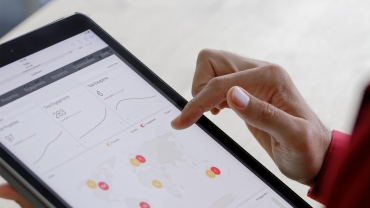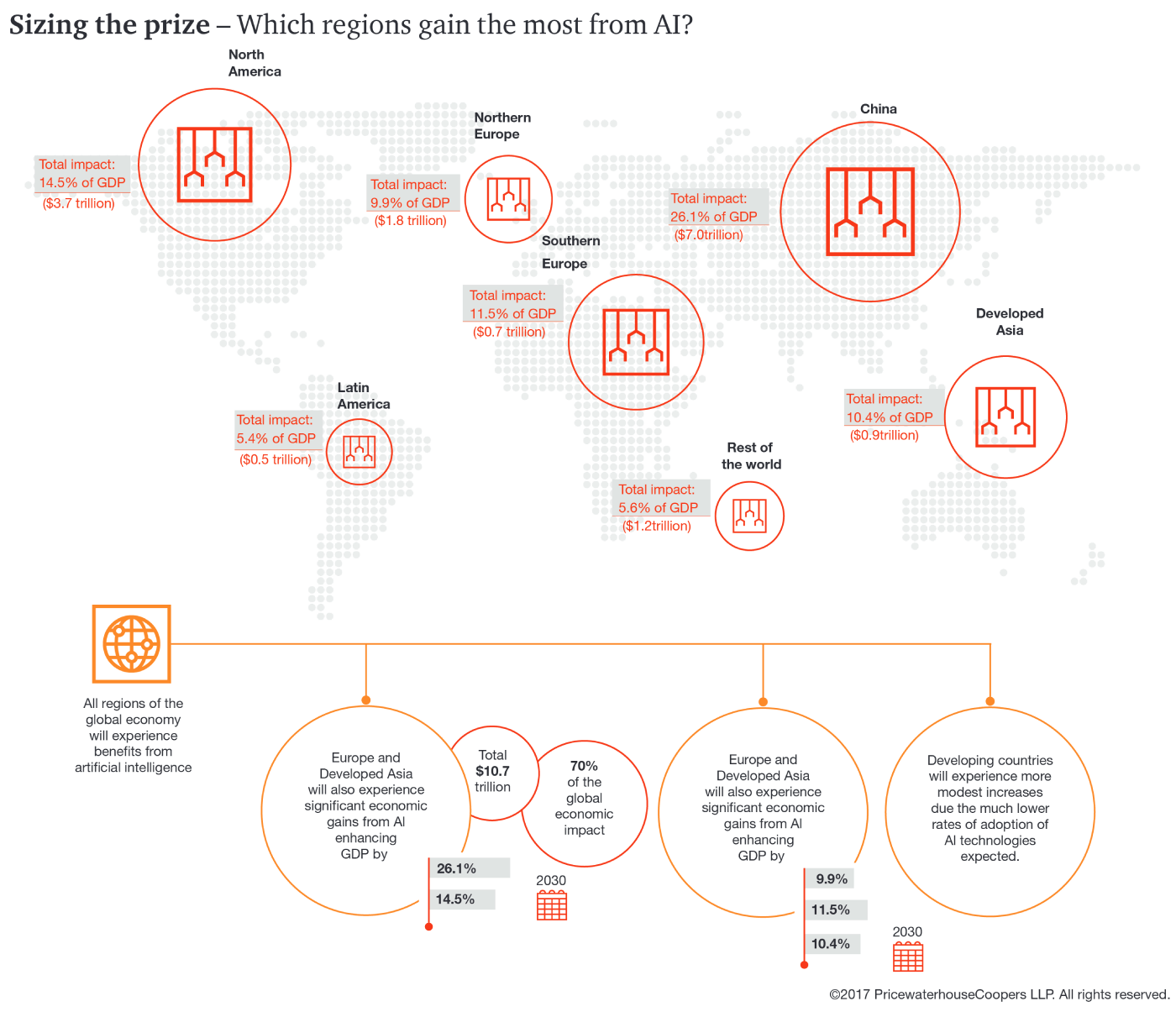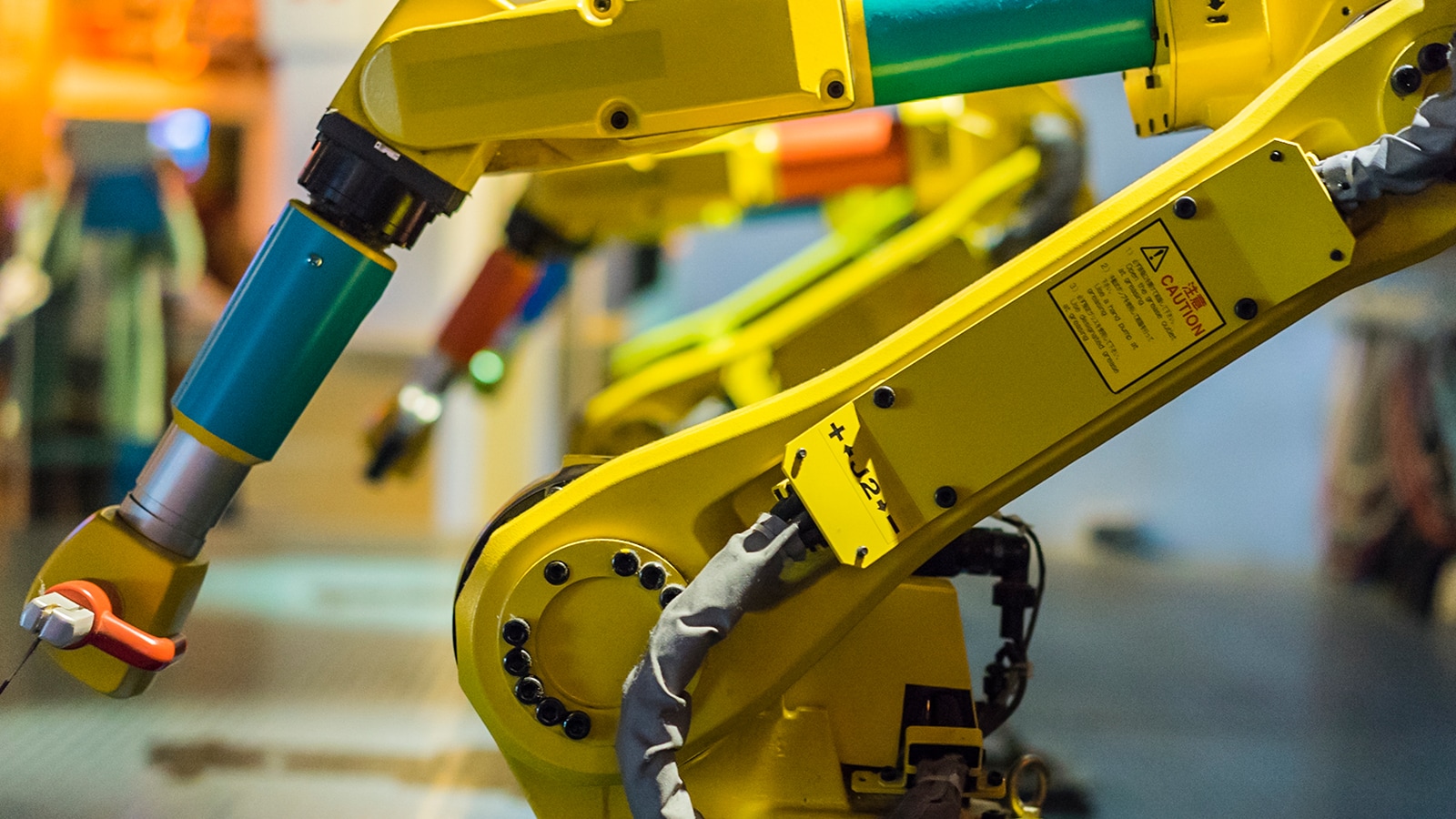
Highlights
- Artificial intelligence (AI) can transform the productivity and GDP potential of the global economy. Strategic investment in different types of AI technology is needed to make that happen.
- Labour productivity improvements will drive initial GDP gains as firms seek to "augment" the productivity of their labour force with AI technologies and to automate some tasks and roles.
- Our research also shows that 45% of total economic gains by 2030 will come from product enhancements, stimulating consumer demand. This is because AI will drive greater product variety, with increased personalisation, attractiveness and affordability over time.
- The greatest economic gains from AI will be in China (26% boost to GDP in 2030) and North America (14.5% boost), equivalent to a total of $10.7 trillion and accounting for almost 70% of the global economic impact.
Explore the global results further using our interactive data tool or see which of your products and services will provide the greatest opportunity for AI. You can also download our report to get a more detailed analysis and commentary on the positive economic outcomes.

$15.7 trillion game changer
Total economic impact of AI in the period to 2030
What comes through strongly from all the analysis we’ve carried out for this report is just how big a game changer AI is likely to be, and how much value potential is up for grabs. AI could contribute up to $15.7 trillion1 to the global economy in 2030, more than the current output of China and India combined. Of this, $6.6 trillion is likely to come from increased productivity and $9.1 trillion is likely to come from consumption-side effects.
While some markets, sectors and individual businesses are more advanced than others, AI is still at a very early stage of development overall. From a macroeconomic point of view, there are therefore opportunities for emerging markets to leapfrog more developed counterparts. And within your business sector, one of today’s start-ups or a business that hasn’t even been founded yet could be the market leader in ten years’ time.
AI impact index
AI is set to be the key source of transformation, disruption and competitive advantage in today’s fast changing economy. In this report we've drawn on the findings to create our AI Impact Index, where we look at how quickly change is coming and where your business can expect the greatest return.
The areas with the biggest potential and associated timelines are designed to help your business target investment in the short- to medium-term.
Explore the AI impact by sector
Explore our findings in the data explorer below - the AI Impact scores range from 1-5 (1 being lowest impact, 5 being highest).
Which of your products and services will provide the greatest opportunity for AI?
Healthcare
High potential use case: Data-based diagnostic support
AI-powered diagnostics use the patient’s unique history as a baseline against which small deviations flag a possible health condition in need of further investigation and treatment. AI is initially likely to be adopted as an aid, rather than replacement, for human physicians. It will augment physicians’ diagnoses, but in the process also provide valuable insights for the AI to learn continuously and improve. This continuous interaction between human physicians and the AI-powered diagnostics will enhance the accuracy of the systems and, over time, provide enough confidence for humans to delegate the task entirely to the AI system to operate autonomously.
Barriers to overcome
It would be necessary to address concerns over the privacy and protection of sensitive health data. The complexity of human biology and the need for further technological development also mean than some of the more advanced applications may take time to reach their potential and gain acceptance from patients, healthcare providers and regulators.
Automotive
High potential use case: Autonomous fleets for ride sharing
Autonomous fleets would enable travellers to access the vehicle they need at that point, rather than having to make do with what they have or pay for insurance and maintenance on a car that sits in the drive for much of the time. Most of the necessary data is available and technology is advancing. However, businesses still need to win consumer trust.
Barriers to overcome
Technology still needs development – having an autonomous vehicle perform safely under extreme weather conditions might prove more challenging. Even if the technology is in place, it would need to gain consumer trust and regulatory acceptance.
Financial services
High potential use case: Personalised financial planning
While human financial advice is costly and time consuming, AI developments such as robo-advice have made it possible to develop customised investment solutions for mass market consumers in ways that would, until recently, only have been available to high net worth (HNW) clients. Finances are managed dynamically to match goals (e.g. saving for a mortgage) and optimise client’s available funds, as asset managers become augmented and, in some cases, replaced by AI. The technology and data is in place, though customer acceptance would still need to increase to realise the full potential.
Barriers to overcome
Consumer trust and regulatory acceptance.
Retail and consumer
High potential use case: Personalised design and production
Instead of being produced uniformly, apparels and consumables can be tailored on demand. If we look at fashion and clothing as an example, we could eventually move to fully interactive and customised design and supply in which AI created mock-ups of garments are sold online, made in small batches using automated production, and subsequent changes are made to design based on user feedback.
Barriers to overcome
Adapting design and production to this more agile and tailored approach. Businesses also need to strengthen trust over data usage and protection.
Technology, communications and entertainment
High potential use case: Media archiving and search
We already have personalised content recommendation within the entertainment sector. Yet there is now so much existing and newly generated (e.g. online video) content that it can be difficult to tag, recommend and monetise. AI offers more efficient options for classification and archiving of this huge vault of assets, paving the way for more precise targeting and increased revenue generation.
Barriers to overcome
Cutting through the noise when there is so much data, much of it unstructured.
Manufacturing
High potential use case: Enhanced monitoring and auto-correction
Self-learning monitoring makes the manufacturing process more predictable and controllable, reducing costly delays, defects or deviation from product specifications. There is huge amount of data available right through the manufacturing process, which allows for intelligent monitoring.
Barriers to overcome
Making the most of supply chain and production opportunities requires all parties to have the necessary technology and be ready to collaborate. Only the biggest and best-resourced suppliers and manufacturers are up to speed at present.
Energy
High potential use case: Smart meters
Smart meters help customers tailor their energy consumption and reduce costs. Greater usage would also open up a massive source of data, which could pave the way for more customised tariffs and more efficient supply.
Barriers to overcome
Technological development and high investment requirements in some of the more advanced areas.
Transport and logistics
High potential use case: Autonomous trucking
Autonomous trucking reduces costs by allowing for increased asset utilisation as 24/7 runtimes are possible. Moreover, the whole business model of transport & logistics (T&L) might be disrupted by new market entrants such as truck manufacturers offering T&L and large online retailers vertically integrating their T&L.
Barriers to overcome
Technology for autonomous fleets is still in development.
Contact us


























